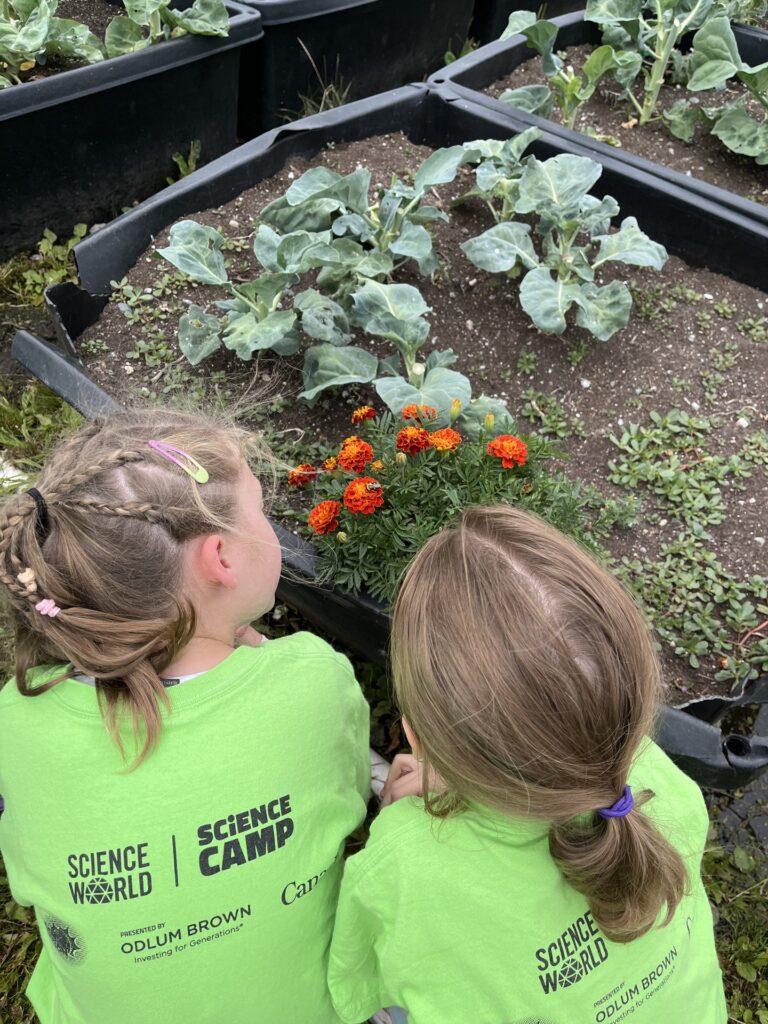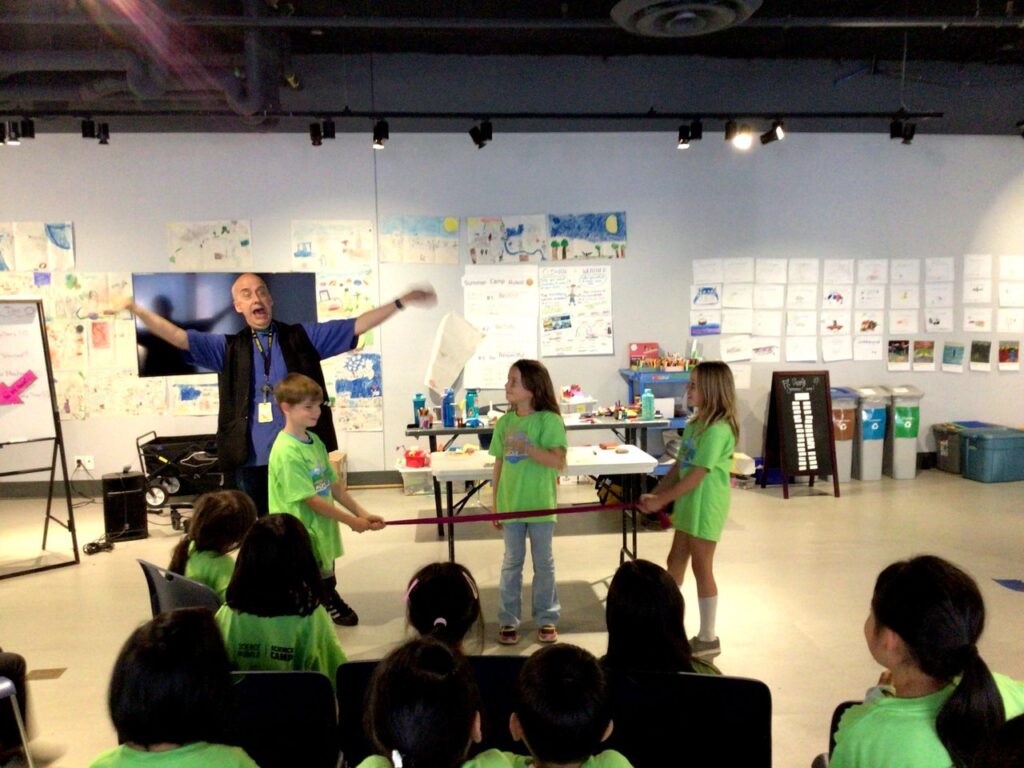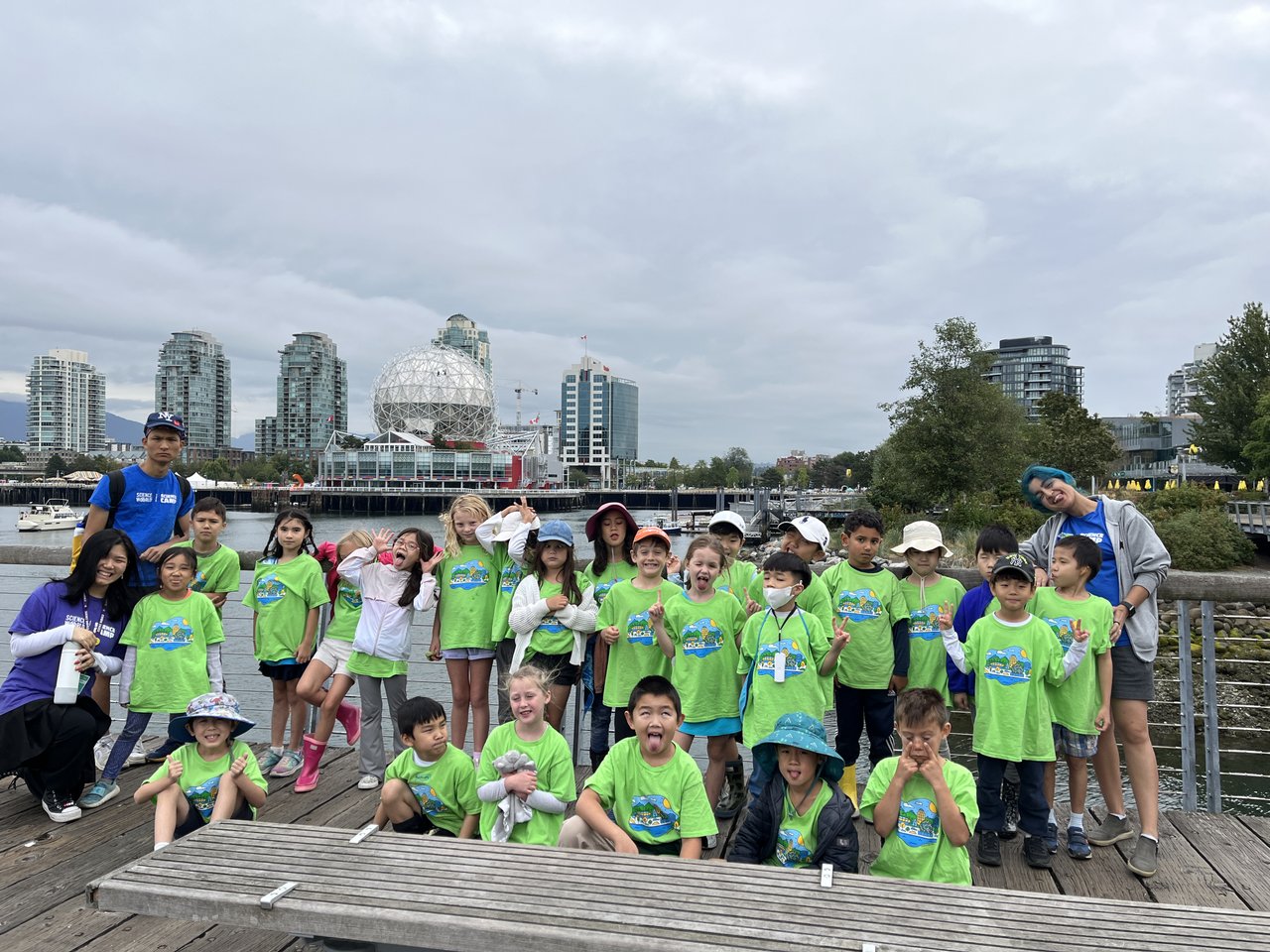Looking for a spring break camp in Vancouver? Science World runs week-long science camps for kids in Kindergarten to Grade 5 from March 17 to 28, 2025.
Campers Rethink City Design
From the rooftop at Science World you can see all the way from the North Shore Mountains to Olympic Village. It’s a spectacular view that on a clear day gives you a glimpse into Vancouver’s past and present, and, if you’re a camper at Science World’s Summer Camp: inspiration for its future.
“To get the week started we brought campers up to the green roof to highlight how the city’s design has changed over time,” says Ali Brennan, Primary Camp Leader at Science World Summer Camp.
“When you look north toward downtown, you see very few buildings with green roofs,” Ali says. “But when you look at the newer buildings along False Creek and Olympic Village, there are far more green roofs. It prompted interesting discussions with our campers; how can we use our city space in different ways to make it more green when we have so much concrete?”
That discussion often sparked another: why does increasing greenery in a cityscape matter in the first place? It’s something campers pondered over the course of the week-long science camps, whose theme this year was climate action.
From Awareness to Action: How Campers Combat Climate Change
“When I tell friends or family that our Summer Camps are about climate change and climate action, the first thing they often say is, ‘Wow, that’s a really anxiety-inducing topic,” says Keanu Moodley, Intermediate Camp Leader.
“But I would say it's the opposite. These kids come in with a lot of knowledge beforehand; they often already know what greenhouse gas is, what climate change is, and how it's impacting our planet,” he says. “So they come in with a mindset of ‘I want to figure out how to solve this problem,’ which I think is really great. And as soon as we give them some of these solutions, they start running with them.”
Putting on Professional Hats: Architects, Designers, and City Planners!
Science World Summer Camps immerse campers in experiential STEAM learning (science, technology, engineering, art & design, and math), while inspiring youth to feel empowered to participate in things that help with climate change and give them realistic ways they can be part of the solution, says Lizzie Titchard, Experiential Learning Manager. When Lizzie and her team developed this year’s Summer Camp, they wanted to encourage campers to put on different hats—those of an architect, a city planner, a designer—and ultimately let them imagine themselves in the shoes of different people, she says.
“It was very important to us that the activities were fun and inspiring and empowered campers to see themselves as part of the solutions for climate change,” she says. “And learn a little something along the way.”

Live Demos Bring Climate Science to Life
In true Science World fashion, the basic principles of climate change were illustrated with live-action demonstrations. For example, to illustrate the concept of thermal expansion, which contributes to sea levels rising, camp leaders filled two balloons: one with water, the other with air. They then placed both balloons above candles and had campers guess which one would pop first.
“Campers almost always guessed it would be the one filled with water,” says Amel Bouanani, Intermediate Camp Leader. “They’re surprised when it’s the one filled with air. And that’s when we explained that water has a high heat capacity so as it absorbs heat, it expands, which is known as thermal expansion.”
One of the goals of the camp was for campers to leave with solutions, some of which are actionable and age-appropriate (like turning off the lights when they leave a room) and others… were made of popsicle sticks.
“From just outside our Bits and Bytes lab, you can see the wind turbine on Grouse Mountain. So we take the campers outside and point that out and talk about how wind is a renewable source of energy,” says Ali.
That wind turbine served as inspiration for campers to make their own models out of wooden dowels and paper.
“They tested different blade shapes and sizes and angles,” says Ali. “And they always had a laugh riot when we turned on a fan to see how it moved. They got so excited when they got it going.”
Toward the end of each week of science camp, leaders introduced the concept of biodiversity and specifically how it can help combat climate change.
Young Scientists Creating a More Biodiverse Future
“The more biodiverse an ecosystem is, the more opportunities it has to adapt to climate change,” says Keanu. “So we make insect hotels as a way to increase the biodiversity of the campers’ favourite outdoor spaces.”
Campers made these insect hotels out of popsicle sticks, but Keanu says any sort of organic material, like wood, would work. Once they framed their insect hotels, campers layered them with different organic materials, depending on the type of insect they’d like to house; for example, bark, dry leaves and sticks for spiders, or pinecones for ladybugs.
“We encourage campers to bring their insect hotels home and set them up in their backyards or favourite park,” Keanu says.
Turning Concrete into Crops: Camp Concludes with a Purposeful Field Trip
While each week of Science World Summer Camp started on the rooftop, it finished at street level with a fieldtrip to Sole Food Farms where campers got to see firsthand how the social enterprise transforms some of the city’s concrete spaces into flourishing agricultural lands.
This experience-rich approach to STEAM learning is made accessible to campers thanks to the support of Odlum Brown, an independent BC-based investment firm that has supported environmental education at Science World since 2021.
“We believe supporting Science World’s climate action education as an important part of our mission to nurture a sustainable future,” says Trevor Short, President at Odlum Brown. “Through initiatives like their Summer Camps, the science centre brings complex concepts to life for young people in a way that is both engaging and inspiring.”
As their final project, campers took turns being science communicators and presented their own climate action statements to family and friends on stage in one of Science World’s theatres.
“Campers would pledge to do things that are within their capacity, like read a book instead of watching television, or collect rainwater to water their garden,” says Lizzie.
“It’s very much hope-focused.”

Don’t let them miss out on a week of hands-on science and adventure!
